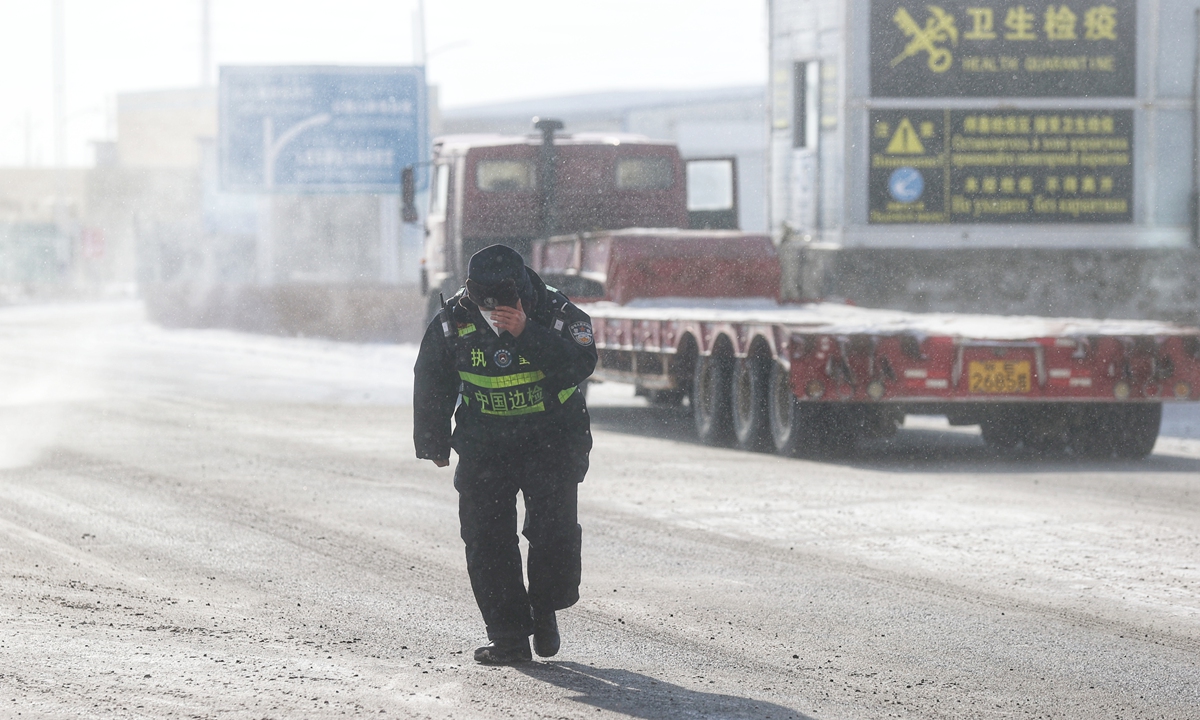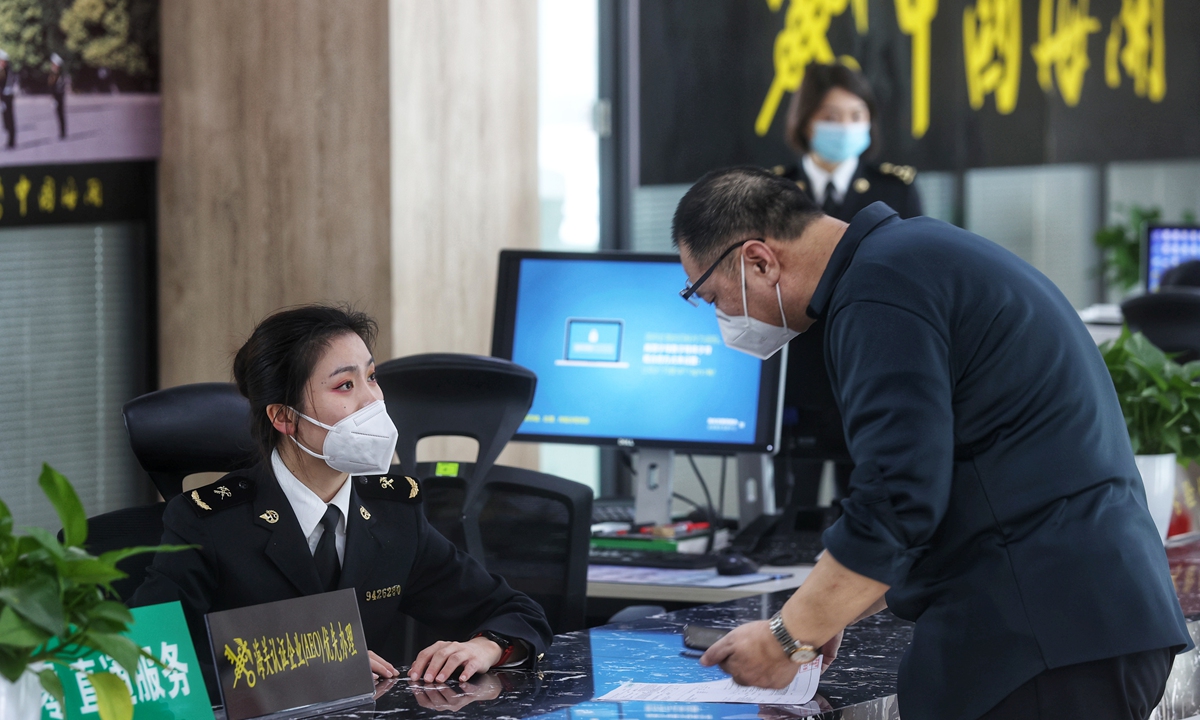
Huang Jiajun bending his body to keep balance with a gale blowing dead against him and snow grains rising along the wind flapped on his face as he was walking close to a truck that was entering a border checkpoin in Alashankou Port,Northwest China's Xinjiang Uygur Autonomous Region. Photo: Cui Meng/GT
Bending his body to keep balance with a gale blowing dead against him and snow grains rising along the wind flapping on his face, Huang Jiajun, the 23-year-old frontier inspection officer, was walking close to a truck that was entering a border checkpoint.
Standing in cold wind, Huang checked passports and other basic information of drivers of cross-border trucks entering from Kazakhstan to Northwest China's Xinjiang Uygur Autonomous Region through Alashankou Port with his bare hands, before guiding the trucks to designated areas for inspection. He has been work in hard conditions for 35 days before taking a shift at a different post.
Located in the heart of the Eurasian continent, Alashankou, an inland port in Xinjiang region, is known as the "windy city." Throughout the year, there are on average more than 180 days of gale force eight or above at the port, and strong winds of gale force 16 are not uncommon. On the day of the interview, the bus carrying the Global Times reporter even swayed in the face of gale with force 12.
The port, once part of the frontline in preventing imported COVID-19 flare-ups, had been closed for travel. With the sole exception being for rail, road and other freight, through which goods from five Central Asian countries and Europe are sold around the world.
To ensure goods can be delivered in and out the country in a timely way through the Belt and Road transportation hub, staff stationed in the windy port, like Huang Jiajun, never stopped its steps in past three years.
Instead of experiencing falling volume of cargo goods passing through the port during the pandemic, the total cargo volume in 2022 through Alashankou Port surpassed 25.3 million tons, up 14.2 percent year on year and 3.89 percent compared with 2019 prior to the epidemic.
Among the 25.3 million, 13.6 million tons passed using railways, 400,000 over highway and 11.2 million through crude oil pipelines, increased 2.3 percent, 149.6 percent and 3.6 percent than 2019.
A sustained effort
Instead of dumping their trailers and being placed under closed-loop management, drivers from Kazakhstan can enter the Chinese territory directly after Huang Jiajun and his colleagues checked incoming vehicles.
The port set up five closed management zones during the epidemic period to guarantee the smooth flow of freight and prevent the occurrence and the spread of the epidemic - the railway station area, the comprehensive protection zone, the customs supervision warehouse and the quarantine point, Wang Lei, director of Alashankou municipal foreign affairs office, told the Global Times.
To ensure their smooth completion of customs clearance, traffic police guided drivers to designated areas through designated routes to reduce risk of imported cases, sometimes, even helped repair broken-down vehicles and delivered food for drivers who were hungry, the Global Times learnt from Su Lingzhi, the traffic police chief in Alashankou.
During the process, frontline staff members were required to wear protective suits during their eight-hour shifts, often ending up soaked to the skin at the end of each day.
The duration for customs clearance at highway pass is usually 10 am to 7:30 pm, but closing the port doesn't mean Huang Jiajun and his colleagues were able to clock off.
When frontier police spotted Chinese drivers stranded in Kazakhstan late at night due to inclement weather, they would always extend their working hours and make the exception to open the port to allow Chinese citizens an opportunity to return home.
"In such cold weather, we cannot leave our compatriots out of the country," said 25-year-old Lu Shiwei from Alashankou frontier inspection department.

A man talks with a customs working staff at the customs inspection hall in Alashankou. Photo: Cui Meng/GT
In customs inspection hall, the Global Times reporters saw Xu Yueheng, an official working with customs. He had been working for 24 hours straight, with his eyes bulging and bloodshot.
Xu Yueheng said that China-Europe freight train routes pass through Alashankou port has been always operating 24 hours, and therefore so did his team.
Over the past three years, family became almost like a distant memory. "My child may not recognize me. I spent very little time with my child. This is what we had to experience because of the epidemic. Now the restrictions due to the epidemic are over, we're encouraged to take a vacation to make up the lost time with family members."
Xu Yueheng plans to bring his 3-year-old child home this year, who is living with his parents in Korla some 900 kilometers away from Alashankou.
Making a difference
Alashankou was built in 2012 as a port city, but young people from across the country are willing to buckle down to do something here and devote their youth to a greater cause. Maybe that's the secret as to why Alashankou has never stopped growing.
Either the 23-year-old Huang Jiajun, 33-year-old Xu Yueheng, 25-year-old Lu Shiwei or 51-year-old Su Lingzhi, they treat Alashankou - a city with harsh environment and faraway port in Xinjiang region - as their home.
"I have witnessed the port developed from nothing to now a 'railway engine' of the country, meanwhile, I grow up with the city, leaning new things from scratch and flourish myself," said Su Lingzhi, who arrived in the city in 1996 and since then stayed.
Those people across the country who gather the port city are buckle down to do something as the fate of this port is closely related to the fate of individuals, said Li Chenlin, vice secretary of party committee of Alashankou city.
Alashankou has a total population of 18,000, with more than 12,000 permanent residents. This small port town located at the northwest border of the motherland generated tariff revenue and import value-added tax in 2022, accounting for 70 percent of the whole Xinjiang region.
This year, the port is aiming to facilitate 26 million tons of annual cargo volume of leaving and entering China.
"Increasing year-on-year cargo transportation always results in congestion of the port in summers. Besides that, the natural environment and its location make it difficult to attract talents. Although it is difficult, we will try our best to achieve it, toward which I totally confident," Li Chenlin said.
As an important port for the country to link the west, Alashankou Port will certainly play a bigger role in Belt and Road Initiative and a bridge connecting Asia with European countries, Li Chenlin noted.



